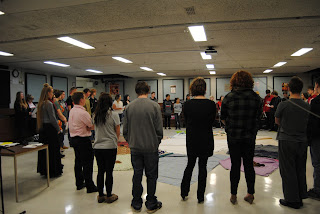My brother, Ian, proud sheep farmer for two years.
I grew up on a farm in Saskatchewan, and I am proud of my heritage. Many farming families came to this land, opened by Treaties, escaping oppression. I have always thought that as farming-folk learn of the oppression -- the genocide -- experienced by First peoples, there should be a natural solidarity between our peoples. I have heard stories of this being the case, of our peoples being good neighbours.
Mae Wesley, a settler descendant elder in the Edgely farming community which neighbours Pasqua First Nation, told me that her dad always said, "If you make a friend with an Indian, you have a friend for life." My own father's grandmother, as a late 1800's bride in the Estevan area, received half a deer, cleaned and hanging in a tree. A gift from her Indigenous neighbours.
On the other hand, what can I say to fellow farmers utilizing the tragedy of August 9th in Biggar, Saskatchewan, as an opportunity to illustrate ignorance. Ignorance of the Treaties, ignorance of privilege, ignorance of colonization, ignorance of genocide, ignorance of the gifts we have been given by the First peoples of this land?
When I heard that the councilor who resigned (after making blatantly racist remarks on social media) was from Lampman, where I was born, I knew I needed to reach out. While visiting my kids in Estevan, I almost drove to Lampman to see if I could find the family. My daughters insisted that it wasn't the right time. Instead, I phoned the National Farmers' Union. I wanted to speak to whoever wrote the press release extending condolences to the Bushie family and condemning racism. "We also commit ourselves to building relationships of solidarity, mutual respect, and friendship with our indigenous neighbours, and honouring our obligations as Treaty people," the NFU concluded.
I spoke with Cathy Holtslander from the National Farmers Union. I thanked her and her organization for their leadership. I asked what actions they intended as they make good on their commitments. We talked for a while, sharing ideas back and forth, and good books kept entering the discussion. Thomas King's
Inconvenient Indian: A Curious Account of Native American People in North America; Sarah Carter's
Lost Harvests: Prairie Indian Reserve Farmers and Government Policy; James Daschuck's Clearing the Plains: Disease, Politics of Starvation, and the Loss of Aboriginal Life; and Paulette Reagan's
Unsettling the Settler Within: Indian Residential Schools, Truth Telling, and Reconciliation in Canada.
This conversation, has got me thinking. What does it mean to be a farmer? What is my farm family's Treaty story? From which Treaty promises have my family benefited? Have Treaty promises been kept to our Indigenous Treaty partners? If so, what are those benefits? If not, why? How does a Saskatchewan farmer honour the Treaties?
http://www.nfu.ca/story/nfu-expresses-condolences-family-colten-boushie
My neice and their Llamas (named Sheeps and Momma).




















